动词宾语宾补
- 格式:docx
- 大小:23.03 KB
- 文档页数:9
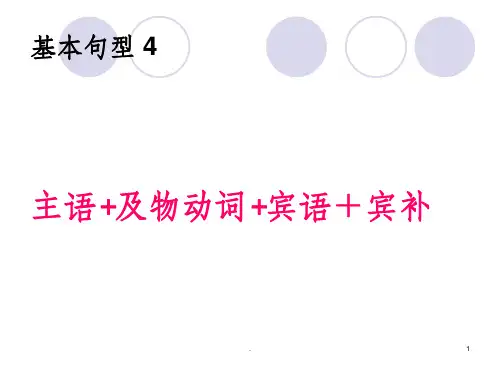

一、“ make宾语+xx”的用法“ make宾语+宾补”这一结构中,宾语补足语可以由名词、形容词、过去分词、不定式等来充当,例如:(1) A good friend is someone who makes you happy(. 形容词作宾补)(2) They made me repeat the story.(省to 的动词不定式)(3) He raised his voice to make himself heard过去分词作宾补)注:“ make宾语+宾补”结构中不用现在分词充当宾补。
(4) We made him monitor of our class.(名词作宾补)注:职务名词充当xx 补时其前面不要加冠词。
【试题链接】1. He is very popular among his students as he always tries to make them___ in his lectures.A.interestedB.interestingC.interestD.to interest2. Myparentshavealwaysmademe___aboutmyself,evenwhenIwastwelve.A.feeling wellB.feeling goodC.feel wellD.feel good答案:1. A2. D二、“ with宾语+xx”的用法“ with宾语+ 宾补”是高考试题中考查十分频繁的结构,“ with宾语+宾补”结构中的宾补主要有形容词、现在分词、过去分词、动词不定式等,在考题中常要求选择宾补的形式,在选择时宾补空间该使用什么形式,主要限决于宾语与宾补的关系,主动关系用现在分词,被动关系则用过去分词,此外,不定式作宾补要表示含义为将来的意味,例如:(2) With everything he need to buy, he went into the store. (不定式作宾补表示将来的含义)(3) With everything he need bought, he left the store. (过去分词作宾补表被动表完成)(4) With my key lost, I couldn ' t ente过m分词作宾补)(5) With nothing to do, I went out for a walk. (不定式作宾补)(6) I went out with the window open. ( 形容词作宾补)另外,“ with宾语+宾补”结构中还可由介词短语、副词短语来充当宾补,如:(1) She said good-bye with tears in her eyes.(2) He left the room with the light still on.试题链接】1. -- C ome on, please give me some ideas about the project. --- Sorry. With somuch work ___ my mind, I almost break down.A.filledB.fillingC.to fillD.being filled2. John received an invitation to dinner, and with his work ___ hegladly accepted it.A.finishedB.finishingC.having finishedD.was finished3. I couldn ' t to my homework with all the noise___.A.going onB.goes onC.went onD.to go on答案:1. B2. A3. A三、“ have宾语+xx”的用法在“have宾语+宾补”这一结构用法中,充当宾补的常用的有do, doing,done和adj,例如:(1) III have my hair cut this after n 我0今天下午要理发(2) I won ' t have you saying to your mother that way.(3) He reaIized that she did not wish to have her go with him.(4) I expect Amy wiII have the tea ready directIy.、/■ I ■ '。
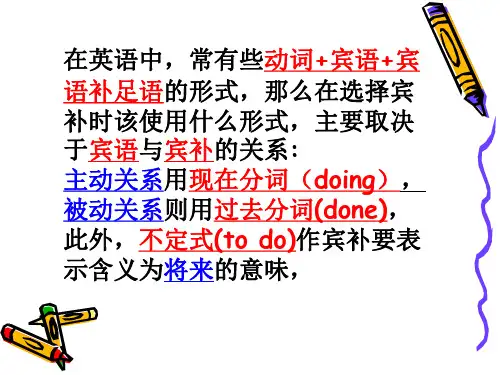

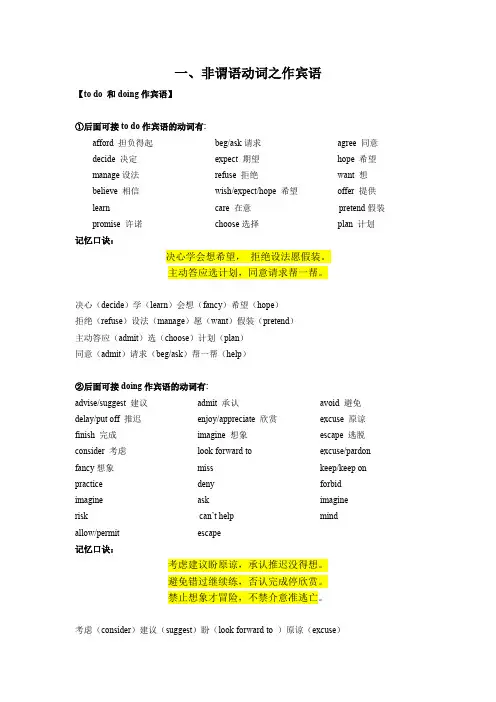
一、非谓语动词之作宾语【to do 和doing作宾语】①后面可接to do作宾语的动词有:afford 担负得起beg/ask请求agree 同意decide 决定expect 期望hope 希望manage设法refuse 拒绝want 想believe 相信wish/expect/hope 希望offer 提供learn care 在意pretend假装promise 许诺choose选择plan 计划记忆口诀:决心学会想希望,拒绝设法愿假装。
主动答应选计划,同意请求帮一帮。
决心(decide)学(learn)会想(fancy)希望(hope)拒绝(refuse)设法(manage)愿(want)假装(pretend)主动答应(admit)选(choose)计划(plan)同意(admit)请求(beg/ask)帮一帮(help)②后面可接doing作宾语的动词有:advise/suggest 建议admit 承认avoid 避免delay/put off 推迟enjoy/appreciate 欣赏excuse 原谅finish 完成imagine 想象escape 逃脱consider 考虑look forward to excuse/pardon fancy想象miss keep/keep on practice deny forbidimagine ask imaginerisk can’t help mindallow/permit escape记忆口诀:考虑建议盼原谅,承认推迟没得想。
避免错过继续练,否认完成停欣赏。
禁止想象才冒险,不禁介意准逃亡。
考虑(consider)建议(suggest)盼(look forward to )原谅(excuse)承认(admit)推迟(put off/delay)没得想(fancy)避免(avoid)错过(miss)继续(continue)练(practice)否认(deny)完成(finish)停(stop)欣赏(admire)禁止(forbid)想象(imagine)才冒险(risk)不禁(can’t help)介意(mind)准逃亡(escape)二、宾语补足语【to do 作为宾语补足语】①后面可接省略to作宾语补足语的动词速记口诀:一感,二听,三让,四看,半帮助一感:feel;二听:hear,listen to;三让:make,let,have;四看:see,notice,watch,observe;半帮助:help②后面接to do作宾语补足语的动词advise 建议allow 允许ask 让,叫want 想要beg 乞求cause 导致command 命令encourage 鼓励expect 期待forbid 禁止force 迫使get 使hate 讨厌leave 让oblige 迫使prefer 宁愿tell 告诉wish 希望help 帮助like 喜欢order 命令request 请求trouble 麻烦wait for 等待intend 想要mean 打算permit 允许remind 提醒bear 忍受would prefer 宁愿invite 邀请need 需要persuade 说服teach 教warn 警告would love 想要记忆口诀:说服建议求期望,忍受命令讨厌讲。

费加罗 刘亦菲不定式在“主语+谓语+宾语+宾语补足语”句型中充当宾语补足语。
在这一句型中,宾语是动词不定式的逻辑主语。
1.在表示感觉的动词后面作宾语补足语,并且不定式都不带to.(被动语态里要带to)这一类动词有:see, hear, feel, watch, notice, observe, look at, listen to,等。
I here them sing yesterday. 昨天我听见他们唱歌了。
Did you see him go out? 你看见他们出去了吗。
I felt something crawl up my leg. 我感到有什么东西爬道我腿上了。
2.在使役动词后作宾语补足语,不定式不带to这一类动词有:make, let,have等。
转为被动语态时,其后通常都用带to的不定式(have没有被动语态)What would you have me do? 你要我做什么?She made him give up smoking.她让他戒烟了。
Let him do whatever he whishes to do.他想干什么就让他干吧。
3.在表示心理状态的动词后作宾语补足语。
这类动词有:consider, think, believe, discover, find, imagine, judge, suppose, prove 等。
这类动词后的不定式通常是“to be+形容词或名词” 结构,think,consider,find后的to be常可省略。
We consider him (to be) a good teacher.我们认为他是一个好老师。
He proved that theory (to be) very important.他证明那个理论是很重要的。
I thought her (to be) nice and honest the first time I mether.我第一次见到她的时候就认为她人很好,很诚实。
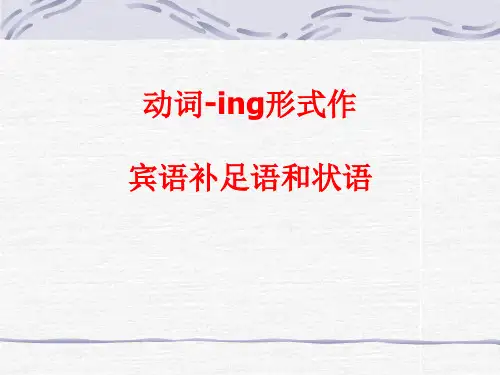
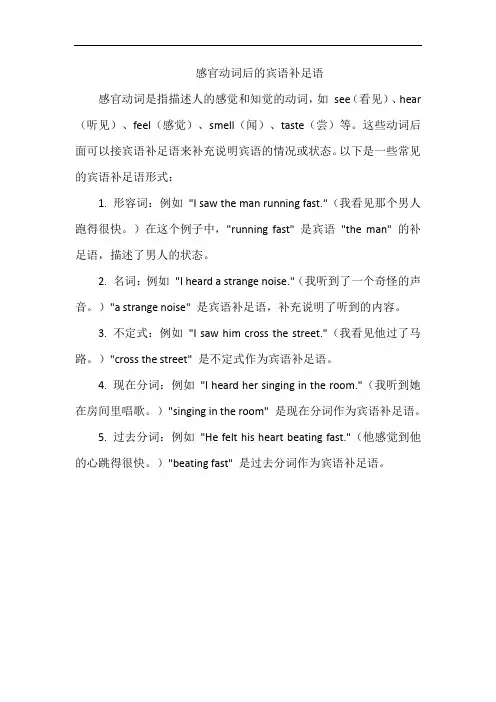
感官动词后的宾语补足语
感官动词是指描述人的感觉和知觉的动词,如see(看见)、hear (听见)、feel(感觉)、smell(闻)、taste(尝)等。
这些动词后面可以接宾语补足语来补充说明宾语的情况或状态。
以下是一些常见的宾语补足语形式:
1. 形容词:例如"I saw the man running fast."(我看见那个男人跑得很快。
)在这个例子中,"running fast" 是宾语"the man" 的补足语,描述了男人的状态。
2. 名词:例如"I heard a strange noise."(我听到了一个奇怪的声音。
)"a strange noise" 是宾语补足语,补充说明了听到的内容。
3. 不定式:例如"I saw him cross the street."(我看见他过了马路。
)"cross the street" 是不定式作为宾语补足语。
4. 现在分词:例如"I heard her singing in the room."(我听到她在房间里唱歌。
)"singing in the room" 是现在分词作为宾语补足语。
5. 过去分词:例如"He felt his heart beating fast."(他感觉到他的心跳得很快。
)"beating fast" 是过去分词作为宾语补足语。
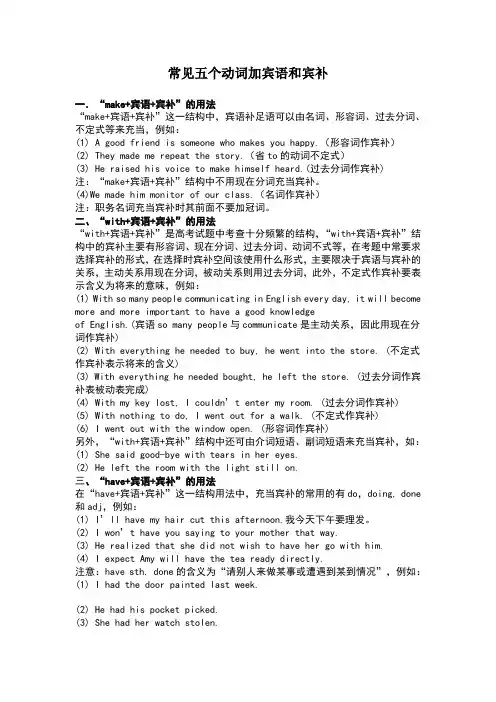
常见五个动词加宾语和宾补一.“make+宾语+宾补”的用法“make+宾语+宾补”这一结构中,宾语补足语可以由名词、形容词、过去分词、不定式等来充当,例如:(1) A good friend is someone who makes you happy.(形容词作宾补)(2) They made me repeat the story.(省to的动词不定式)(3) He raised his voice to make himself heard.(过去分词作宾补)注:“make+宾语+宾补”结构中不用现在分词充当宾补。
(4)We made him monitor of our class.(名词作宾补)注:职务名词充当宾补时其前面不要加冠词。
二、“with+宾语+宾补”的用法“with+宾语+宾补”是高考试题中考查十分频繁的结构,“with+宾语+宾补”结构中的宾补主要有形容词、现在分词、过去分词、动词不式等,在考题中常要求选择宾补的形式,在选择时宾补空间该使用什么形式,主要限决于宾语与宾补的关系,主动关系用现在分词,被动关系则用过去分词,此外,不定式作宾补要表示含义为将来的意味,例如:(1) With so many people communicating in English every day, it will become more and more important to have a good knowledgeof English.(宾语so many people与communicate是主动关系,因此用现在分词作宾补)(2) With everything he needed to buy, he went into the store. (不定式作宾补表示将来的含义)(3) With everything he needed bought, he left the store. (过去分词作宾补表被动表完成)(4) With my key lost, I couldn’t enter my room. (过去分词作宾补)(5) With nothing to do, I went out for a walk. (不定式作宾补)(6) I went out with the window open. (形容词作宾补)另外,“with+宾语+宾补”结构中还可由介词短语、副词短语来充当宾补,如:(1) She said good-bye with tears in her eyes.(2) He left the room with the light still on.三、“have+宾语+宾补”的用法在“have+宾语+宾补”这一结构用法中,充当宾补的常用的有do,doing, done 和adj,例如:(1) I’ll have my hair cut this afternoon.我今天下午要理发。
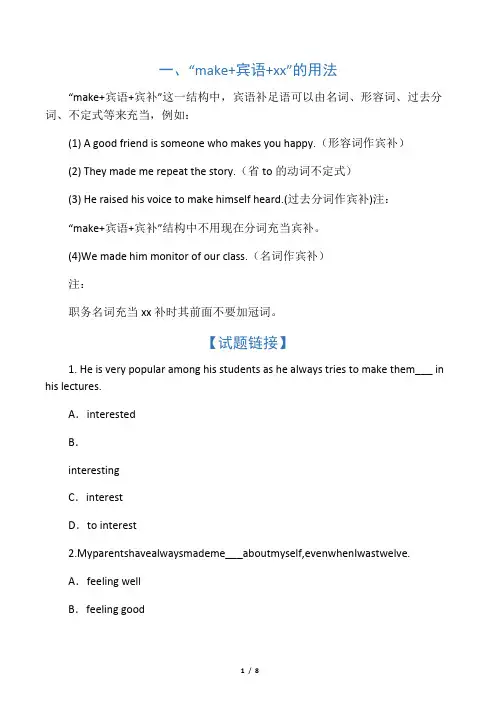
一、“make+宾语+xx”的用法“make+宾语+宾补”这一结构中,宾语补足语可以由名词、形容词、过去分词、不定式等来充当,例如:(1) A good friend is someone who makes you happy.(形容词作宾补)(2) They made me repeat the story.(省to的动词不定式)(3) He raised his voice to make himself heard.(过去分词作宾补)注:“make+宾语+宾补”结构中不用现在分词充当宾补。
(4)We made him monitor of our class.(名词作宾补)注:职务名词充当xx补时其前面不要加冠词。
【试题链接】1. He is very popular among his students as he always tries to make them___ in his lectures.A.interestedB.interestingC.interestD.to interest2.Myparentshavealwaysmademe___aboutmyself,evenwhenIwastwelve.A.feeling wellB.feeling goodC.feel wellD.feel good答案:1.A2.D二、“with+宾语+xx”的用法“with+宾语+宾补”是高考试题中考查十分频繁的结构,“with+宾语+宾补”结构中的宾补主要有形容词、现在分词、过去分词、动词不定式等,在考题中常要求选择宾补的形式,在选择时宾补空间该使用什么形式,主要限决于宾语与宾补的关系,主动关系用现在分词,被动关系则用过去分词,此外,不定式作宾补要表示含义为将来的意味,例如:(2) With everything he need to buy, he went into the store. (不定式作宾补表示将来的含义)(3) With everything he need bought, he left the store. (过去分词作宾补表被动表完成)(4) With my key lost, I couldn’t enter my room. (过去分词作宾补)(5) With nothing to do, I went out for a walk. (不定式作宾补)(6) I went out with the window open. (形容词作宾补)另外,“with+宾语+宾补”结构中还可由介词短语、副词短语来充当宾补,如:(1) She said good-bye with tears in her eyes.(2) He left the room with the light still on.【试题链接】1. ----Come on, please give me some ideas about the project.----Sorry. With so much work ___ my mind, I almost break down.A.filledB.fillingC.to fillD.being filled2. John received an invitation to dinner, and with his work ___ hegladly accepted it.A.finishedB.finishingC.having finishedD.was finished3. I couldn’t to my homework with all the noise___.A.going onB.goes onC.went onD.to go on答案:1. B2. A3. A三、“have+宾语+xx”的用法在“have+宾语+宾补”这一结构用法中,充当宾补的常用的有do,doing,done 和adj,例如:(1) I’ll have my hair cut this afternoon.我今天下午要理发。
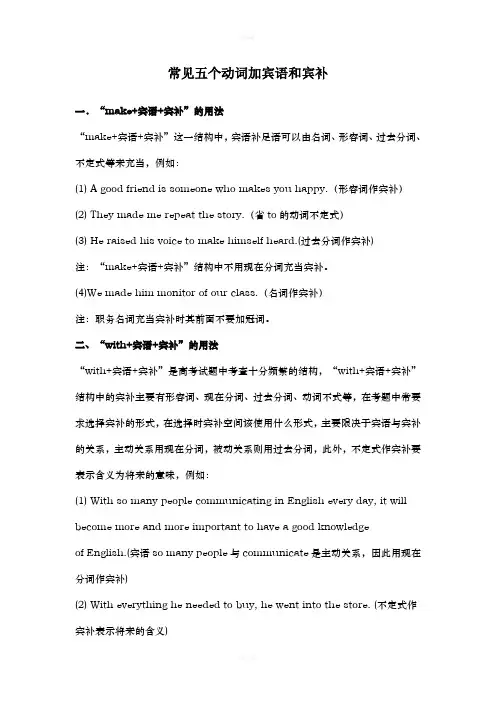
常见五个动词加宾语和宾补一.“make+宾语+宾补”的用法“make+宾语+宾补”这一结构中,宾语补足语可以由名词、形容词、过去分词、不定式等来充当,例如:(1) A good friend is someone who makes you happy.(形容词作宾补)(2) They made me repeat the story.(省to的动词不定式)(3) He raised his voice to make himself heard.(过去分词作宾补)注:“make+宾语+宾补”结构中不用现在分词充当宾补。
(4)We made him monitor of our class.(名词作宾补)注:职务名词充当宾补时其前面不要加冠词。
二、“with+宾语+宾补”的用法“with+宾语+宾补”是高考试题中考查十分频繁的结构,“with+宾语+宾补”结构中的宾补主要有形容词、现在分词、过去分词、动词不式等,在考题中常要求选择宾补的形式,在选择时宾补空间该使用什么形式,主要限决于宾语与宾补的关系,主动关系用现在分词,被动关系则用过去分词,此外,不定式作宾补要表示含义为将来的意味,例如:(1) With so many people communicating in English every day, it will become more and more important to have a good knowledgeof English.(宾语so many people与communicate是主动关系,因此用现在分词作宾补)(2) With everything he needed to buy, he went into the store. (不定式作宾补表示将来的含义)(3) With everything he needed bought, he left the store. (过去分词作宾补表被动表完成)(4) With my key lost, I couldn’t enter my room. (过去分词作宾补)(5) With nothing to do, I went out for a walk. (不定式作宾补)(6) I went out with the window open. (形容词作宾补)另外,“with+宾语+宾补”结构中还可由介词短语、副词短语来充当宾补,如:(1) She said good-bye with tears in her eyes.(2) He left the room with the light still on.三、“have+宾语+宾补”的用法在“have+宾语+宾补”这一结构用法中,充当宾补的常用的有do,doing, done 和adj,例如:(1) I’ll have my hair cut this afternoon.我今天下午要理发。
非谓语动词作宾语,宾补1、动词+doing 动+宾enjoy doing sth. 喜欢做某事spend...doing sth. 花费…做某事be busy doing sth. 忙于做…imagine sb. doing sth. 想象…做某事can't help doing sth. 忍不住做某事feel like doing sth. 想要做某finish doing sth. 完成做某事practice doing sth. 练习做某事miss doing sth. 错过做某事suggest doing sth. 建议做某事keep (on) doing sth. 保持(继续)做某事mind doing sth. 介意做某事be worth doing sth. 值得做某事consider doing sth. 考虑做某事2、介词+doing 介+宾be good at doing sth 擅长做某事be interested in doing sth.对做某事感兴趣insist on doing 坚持做某事put off doing 推迟做某事be used for doing sth. 被用来做某事thank sb. for doing sth. 谢谢某人做某事be tired of doing sth. 厌烦做某事be afraid of doing sth. 害怕做某事stop sb. from doing sth. 阻止某人做某事give up doing sth. 放弃做某事without doing sth. 没有做某事think about doing sth. 考虑做某事What / How about doing 做某事怎么样? look forward to doing sth. (盼望)pay attention to doing sth. (注意)be used to doing sth. (习惯于)prefer doing sth to doing sth.(更喜欢)devote to doing sth (致力于)make a contribution to doing (做贡献)3、动词+to do 动+宾,不定式作宾语decide to do sth. 决定做某事want ∕would like to do sth. 想做某事plan to do sth. 计划做某事need to do sth. 需要做某事agree to do sth. 同意做某事afford to do 能做某事be used to do 被用来做can’t wait to do 迫不及待地要做某事make up one’s mind to do 下决心做某事used to do 过去常常做某事fail to do 失败做某事4、常用带to 的不定式作宾语补足语ask sb. to do sth. 请求某人做某事tell sb. to do sth. 命令某人做某事want sb. to do sth. 想要某人做某事invite sb. to do sth. 邀请某人做某事expect sb. to do sth. 期待某人做某事encourage sb. to do sth. 鼓励某人做某事advise sb. to do sth. 建议某人做某事promise sb. to do 答应某人做某事warn sb. to do sth. 告诫某人做某事allow sb. to do sth. 允许某人做某事remind sb. to do sth. 提醒某人做某事help sb. (to) do sth. 帮助某人做某事5、不带to 的不定式作宾语补足语使役动词和感官动词后:feel/ hear, / let ,make, have, / see, watch, notice + sb + do/doing sth+ do表示动作的完整性,+doing 表示动作的进行性。
V.+宾语+宾补?高考全解析“动词+宾语+宾补”的试题是高考试题中常考的知识点,这里呢,我就高考常考的能跟接“宾语+宾补”复合结构的动词进行着重讲解,以帮助亲们掌握这一知识点:一、“make+宾语+宾补”的用法“make+宾语+宾补”这一结构中,宾语补足语可以由名词、形容词、过去分词、不定式等来充当,例如:(1)A?good?friend?is?someone?who?makes?you?happy.(形容词作宾补)(2)They?made?me?repeat?the?story.(省to的动词不定式)(3)He?raised?his?voice?to?make?himself?heard.(过去分词作宾补)注:“make+宾语+宾补”结构中不用现在分词充当宾补。
(4)We?made?him?monitor?of?our?class.(名词作宾补)注:职务名词充当宾补时其前面不要加冠词。
【高考试题链接】1.?He?is?very?popular?among?his?students?as?he?always?tries?to?make?them?_____?in?his lectures.(07江苏卷)A.interestedB.interestingC.interestD.to?interest2.?My?parents?have?always?made?me?_____?about?myself,?even?when?I?was?twelve.(07江苏卷)A.feeling?wellB.feeling?goodC.feel?wellD.feel?good答案:1.A?2.D二、“with+宾语+宾补”的用法“with+宾语+宾补”是高考试题中考查十分频繁的结构,“with+宾语+宾补”结构中的宾补主要有形容词、现在分词、过去分词、动词不定式等,在考题中常要求选择宾补的形式,在选择时宾补空间该使用什么形式,主要限决于宾语与宾补的关系,主动关系用现在分词,被动关系则用过去分词,此外,不定式作宾补要表示含义为将来的意味,例如:(1)With?so?many?people?communicating?in?English?every?day,?it?will?become?more?and moreimportanttohaveagoodknowledgeofEnglish.(宾语so?many?people与communicate 是主动关系,因此用现在分词作宾补)(2)With?everything?he?needed?to?buy,?he?went?into?the?store.(不定式作宾补表示将来的含义)(3)With?everything?he?needed?bought,?he?left?the?store.(过去分词作宾补表被动表完成)(4)With?my?key?lost,?I?couldn’t?enter?my?room.(过去分词作宾补)(5)Withnothingtodo,Iwentoutforawalk.(不定式作宾补)(6)I?went?out?with?the?window?open.(形容词作宾补)另外,“with+宾语+宾补”结构中还可由介词短语、副词短语来充当宾补,如:(1)She?said?good-bye?with?tears?in?her?eyes.(2)He?left?the?room?with?the?light?still?on.【高考试题链接】1.—Come?on,?please?give?me?some?ideas?about?the?project.—Sorry.?With?so?much?work?______?my?mind,?I?almost?break?down.(07福建卷) A.filledB.fillingC.to?fillD.being?filled2.?John?received?an?invitation?to?dinner,?and?with?his?work?______?he?gladly?accepted it.(07安徽卷)A.finishedB.finishingC.having?finishedD.was?finished3.?I?couldn’t?to?my?homework?with?all?the?noise______.(05北京)A.going?onB.goes?onC.went?onD.to?go?on答案:1.?B2.?A?3.?A三、“have+宾语+宾补”的用法在“have+宾语+宾补”这一结构用法中,充当宾补的常用的有do,doing,?done和adj,例如:(1)I’ll?have?my?hair?cut?this?afternoon.我今天下午要理发。
宾语和宾语补足语的区别宾语(Object)和宾补(Object Complement)是句子中的两个独立成分,它们在意义和语法功能上有着明显的区别。
一、宾语宾语是指动词的直接接受者,它通常回答“谁?”或“什么?”的问题。
宾语一般位于及物动词或介词之后。
例如:1. I eat an apple.(我吃了一个苹果。
)2. She loves her cat.(她爱她的猫。
)从上面的例子可以看出,宾语是动作的承受者,它是句子中的主要成分,可以是名词、代词、短语或从句。
它的作用是对主语的动作进行完善和具体化。
二、宾补宾补是对宾语进行补充说明或更进一步说明,它通常回答“如何?”或“是什么?”的问题,进一步扩展了宾语的意义。
宾补通常出现在使役动词、感官动词、使动动词或称为“静态动词”的系动词之后。
例如:1. They elected him president.(他们选举了他为总统。
)2. The teacher made the students quiet.(老师让学生保持安静。
)从上面的例子可以看出,宾补直接跟在宾语后面,对其进行补充说明。
它可以是形容词、名词、介词短语、不定式、分词等,用来补充和修饰宾语。
宾补与宾语的最主要区别在于:1. 宾补是对宾语的进一步补充或说明,它强调补充的内容与宾语之间的关系;而宾语则是动作的承受者,它更直接地接受动作。
2. 宾补的存在是为了完善宾语的意义,扩展宾语的信息;而宾语本身则是动作的指向对象。
3. 当动词的意义需要进一步说明时,用宾补;当动词的意义已经明确无需补充时,用宾语即可。
总体来说,宾补起到对宾语进行进一步说明和补充的作用,对句子的意义和信息起到了一定的拓展。
宾补和宾语在句子中扮演了不同的角色,并且具有不同的语法功能。
因此,在学习和理解句子结构和语法规则时,需要注意宾语与宾补的区别。
什么是宾补宾补的举例英语中存在大量的在句法上宾补次序比较灵活的句子,那么你对宾补了解多少呢?以下是由店铺整理关于什么是宾补的内容,希望大家喜欢!宾补的介绍宾语补足语指在英语中有些及物动词,接了宾语意义仍不完整,还需要有一个其他的句子成分,来补充说明宾语的意义、状态等,简称宾补。
宾语和它的补足语构成复合宾语。
而复合宾语的第一部分通常由名词或代词充当,第二部分表示第一部分的名词或代词发出的动作或身份、特征等,称为宾语补足语。
宾补的举例I'm going to paint it pink.我打算把它涂成粉红色(选自《新概念英语第一册》)句子中的“it”显然是宾语。
但是主语将要做的并不是it,而是“paint it pink”。
“pink”是句子中的宾语补足语。
它和宾语之间是逻辑上的主谓关系,也就是说从逻辑上来讲,是pink呈现了it的状态,让句子意思更加完整。
这里的宾语it与宾补pink的关系是系动词与表语的关系(即主系表结构),如大家所知,主系表结构是为了呈现主语的特点特征、状态、身份等信息。
本质意思是it is pink,形式表现是it pink。
句子中的“pink”是形容词做宾语补足语。
能够充当宾补的大致还有:不定式,现在分词,过去分词,副词,介宾短语。
一般情况下,宾补通常紧跟在宾语之后。
比如:I find learning English difficult.(difficult是形容词做宾补)I saw the kite up and down.(up and down是副词做宾补)Tom made the girl cry.(cry是省略不定式符号to的动词不定式) 常跟复合宾语的动词有:call(叫),named(叫做),make(做),think(思考),find(找),leave(离开),keep(保持),nominate(任命),choose,elect(选举),define(定义),regard(认为),see(看),recognize(认出),treat,take,consider(考虑),look up,refer to(提到),accept(接受),acknowledge(承认),describe,depict(描述),represent(表现出),declare(宣称),denounce(指责),employ(雇佣),use(使用),show(展示),organize,express(表达)等。
V.+宾语+xx高考全解析“动词+宾语+宾补”的试题是高考试题中常考的知识点,这里呢,我就高考常考的能跟接“宾语+宾补”复合结构的动词进行着重讲解,以帮助亲们掌握这一知识点:一、“make+宾语+xx”的用法“make+宾语+宾补”这一结构中,宾语补足语可以由名词、形容词、过去分词、不定式等来充当,例如:(1)A good friend is someone who makes you happy.(形容词作宾补)(2)They made me repeat the story.(省to的动词不定式)(3)He raised his voice to make himself heard.(过去分词作宾补)注:“make+宾语+宾补”结构中不用现在分词充当宾补。
(4)We made him monitor of our class.(名词作宾补)注:职务名词充当xx补时其前面不要加冠词。
【高考试题链接】1. He is very popular among his students as he always tries to make them ___ in hislectures.(07江苏卷)A.interestedB.interestingC.interestD.to interest2. My parents have always made me ___ about myself, even when I was twelve.(07江苏卷)A.feeling wellB.feeling goodC.feel wellD.feel good答案:1.A2.D二、“with+宾语+xx”的用法“with+宾语+宾补”是高考试题中考查十分频繁的结构,“with+宾语+宾补”结构中的宾补主要有形容词、现在分词、过去分词、动词不定式等,在考题中常要求选择宾补的形式,在选择时宾补空间该使用什么形式,主要限决于宾语与宾补的关系,主动关系用现在分词,被动关系则用过去分词,此外,不定式作宾补要表示含义为将来的意味,例如:(2)With everything he need to buy, he went into the store.(不定式作宾补表示将来的含义)(3)With everything he need bought, he left the store.(过去分词作宾补表被动表完成)(4)With my key lost, I couldn’t enter my room.(过去分词作宾补)(5)With nothing to do, I went out for a walk.(不定式作宾补)(6)I went out with the window open.(形容词作宾补)另外,“with+宾语+宾补”结构中还可由介词短语、副词短语来充当宾补,如:(1) She said good-bye with tears in her eyes.(2) He left the room with the light still on.【高考试题链接】1.—Come on, please give me some ideas about the project.—Sorry. With so much work ___ my mind, I almost break down.(07福建卷)A.filledB.fillingC.to fillD.being filled2. John received an invitation to dinner, and with his work ___ he gladly acceptedit.(07安徽卷)A.finishedB.finishingC.having finishedD.was finished3. I couldn’t to my homework with all the noise___.(05北京)A.going onB.goes onC.went onD.to go on答案:1. B2. A3. A三、“have+宾语+xx”的用法在“have+宾语+宾补”这一结构用法中,充当宾补的常用的有do,doing, done和adj,例如:(1) I’ll have my hair cut this afternoon.我今天下午要理发。
(2) I won’t have you saying to your mother that way.(3) He realized that she did not wish to have her go with him.(4) I expect Amy will have the tea ready directly.注意:have sth done的含义为“请别人来做某事或遭遇到某到情况”,例如:(1)I had the door painted last week.(2)He had his pocket picked.(3)She had her watch stolen.【高考试题链接】1. Jenny hopes that Mr. Smith will suggest a good way to have her written English ___ in a short period.(07福建卷)A.improvedB.improvingC.to improveD.improveA.has it fixedB.had fixed itC.had it fixedD.fixed it3.You should understand the traffic rule by now. You’ve had it ___ often enough.(05天津)A.explaingB.to explainC.explainD.explained答案:1. A2. C3. D四、“find+宾语+xx”的用法“find+宾语+宾补”这一结构中的宾语补足语可以由现在分词、过去分词、名词、形容词、副词、介词短语以及不定式to be等来充当。
分别举例如下:(1)You will find it a very difficult book.(2)The youth found it a hard problem to think about.(3)When he came to himself, he found himself surrounded by a group of boys.(4)I hope to find you in better spirits when we meet again.(5)I find the Chinese people to be happy and cheerful.注意:find+宾语+宾补这一结构中通常不使用动词原形来充当宾语补足语,即没有“find+宾语+动词原形”这样的结构。
【高考试题链接】A cook will be immediately fired if he is found __ in the kitchen.(03全国卷)A.smokeB.smokingC.to smokeD.smoked答案:B。
五、“leave+宾语+xx”的用法Leave+宾语+宾语补足语,其中宾语补足这一成分可以由过去分词、现在分词、形容词、介词的复合结构等来充当,分述如下:1.由过去分词来充当宾语补足语:leave sth/sb done,常用来表示宾语所处的状态或表示动作已经完成。
(1)Please excuse me if I have left any of your questions unanswered.(2)He got up slowly leaving the lunch unfinished.(3)Did you leave the doors and windows firmly fastened? △可用于被动语态:Hi!My patient can’t be left unattached.2.由现在分词来充当宾语补足语:leave sb/sth doing,常用来表示使某人或某物一直做某事:(1)Don’t leave her waiting outside in the rain.(2)They went off together and left me sitting there.(3)We left him painting the gate.△可用于被动语态:Now the temple has only its walls left standing.The papers were left lying around.3.由形容词来充当宾语补足语:(1)You’d better leave the drawing-room door open.(2)His illness has left him weak.△可用于被动语态:The window was left open.4.由介词的复合结构充当宾语补足语:(1)Leave him in peace!(2)His illness left him with a weak heart.(3)You’ve l eft her name off the list.△可用于被动语态:I was left without a ray of hope.【高考试题链接】A good story does not necessarily have to have a happy ending, but the reader must not be left___.(06天津卷)A.unsatisfiedB.unsatisfyingC.to be unsatisfyingD.being unsatisfied答案:A六、“hear+宾语+xx”的用法“hear+宾语+宾补”这一结构中的宾补常可以由现在分词、不带to的不定式、过去分词等来充当,如:Through the wall he could hear Harris cleaning his teeth.She could hear the rain pattering against the windows.Have you ever heard a pop song sung in Japanese?I won’t hear anything said against him behind his back.【高考试题链接】After a knock at the door, the child heard his mother’s voice ___ him.(07上海卷)A.callingB.calledC.being calledD.to call 答案:A。